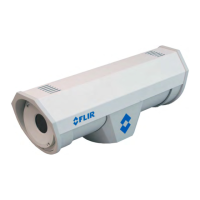427-0030-00-12, Version 170 Mar 2014 2-15
2 Basic Operation and Configuration
2.7 Thermal Imaging Overview
When power is applied to the F-Series camera, a FLIR splash
screen is displayed for less than two seconds, and then the camera
outputs the live video image. No operator action or intervention is
required and no configuration of the camera is necessary.
The thermal camera makes an image based on temperature
differences. In the thermal image, by default the hottest item in the
scene appears as white and the coldest item is black, and all other
items are represented as a grey scale value between white and
black.
It may take some time to get used to the thermal imagery from the camera, especially for someone
who only has experience with normal daylight cameras. Having a basic understanding of the
differences between thermal and daylight cameras can help with getting the best performance from
the thermal camera.
Both thermal and daylight cameras have detectors (pixels) that detect energy. One difference
between thermal and daylight cameras has to do with where the energy comes from to create an
image. When viewing an image with an ordinary camera, there has to be some source of visible light
(something hot, such as the sun or lights) that reflects off the objects in the scene to the camera. The
same is true with human eyesight; the vast majority of what people see is based on reflected light
energy.
On the other hand, the thermal
camera detects energy that is
directly radiated from objects in the
scene. Most objects in typical
surroundings are not hot enough to
radiate visible light, but they easily
radiate the type of infrared energy
that the thermal camera can detect.
Even very cold objects, like ice and
snow, radiate this type of energy.
The camera is capable of sensing
very small temperature differences,
and produces a video image that
typically has dramatic contrast in
comparison to daylight cameras. This
high contrast level from the thermal
video enables intelligent video
analytic software to perform more
reliably.
The performance of the camera will likely vary throughout the day. Right after sunset, objects warmed
by the sun will appear warmest. Early in the morning, many of these objects will appear cooler than
their surroundings, so be sure to look for subtle differences in the scene, as opposed to just hot
targets.
Originally developed for the military, thermal imaging cameras are now deployed in numerous
commercial applications where it is impractical or too expensive to use active illumination (lights).
Figure 2-3: Splash Screen

